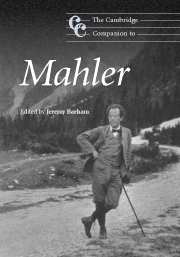Book contents
- Frontmatter
- Introduction: Marginalia on Mahler today
- PART ONE Cultural contexts
- 1 Socio-political landscapes: reception and biography
- 2 The literary and philosophical worlds of Gustav Mahler
- 3 Music and aesthetics: the programmatic issue
- PART TWO Mahler the creative musician
- PART THREE Mahler the re-creative musician
- PART FOUR Reception and performance
- Appendix: selected discography
- Notes
- Bibliography
- Index
1 - Socio-political landscapes: reception and biography
from PART ONE - Cultural contexts
Published online by Cambridge University Press: 28 September 2011
- Frontmatter
- Introduction: Marginalia on Mahler today
- PART ONE Cultural contexts
- 1 Socio-political landscapes: reception and biography
- 2 The literary and philosophical worlds of Gustav Mahler
- 3 Music and aesthetics: the programmatic issue
- PART TWO Mahler the creative musician
- PART THREE Mahler the re-creative musician
- PART FOUR Reception and performance
- Appendix: selected discography
- Notes
- Bibliography
- Index
Summary
In 1904 the Prussian Ambassador to the Grand Duchy of Weimar sent an anxious report to his masters at Wilhelm II's court in Berlin. It concerned the promotion of ‘modern’ artists like Gaugin and Rodin by the Director of Weimar's Grand Ducal Museum for Arts and Crafts, the homosexual connoisseur, soldier and diplomat, Count Harry Kessler. For the Ambassador, Kessler's modernism (something which inspired ‘the known aversion of His Majesty the Emperor and King’) was comprehensible only as a form of sedition on the part of ‘intriguers’ with partisan interests; ‘an artistic opposition’, he concluded, ‘can, at times, easily lead to a political [one]’. It is small wonder that in 1918 this same Kessler, otherwise known to music history as co-librettist with Hofmannsthal for Richard Strauss's ballet Josephslegende, would adopt striking language in the exercise of his later war-time position (following harrowing active service) as Cultural Attaché to the German embassy in Switzerland: ‘The propaganda war has become through the engagement of the Americans more vehement and complicated. They have more money, we have the craftiness of our Jews, which I put into motion, and our more precise work. Every moment in life, every individual, becomes the battlefield of enemy parties. Nothing escapes politics.’
- Type
- Chapter
- Information
- The Cambridge Companion to Mahler , pp. 5 - 20Publisher: Cambridge University PressPrint publication year: 2007
- 1
- Cited by

